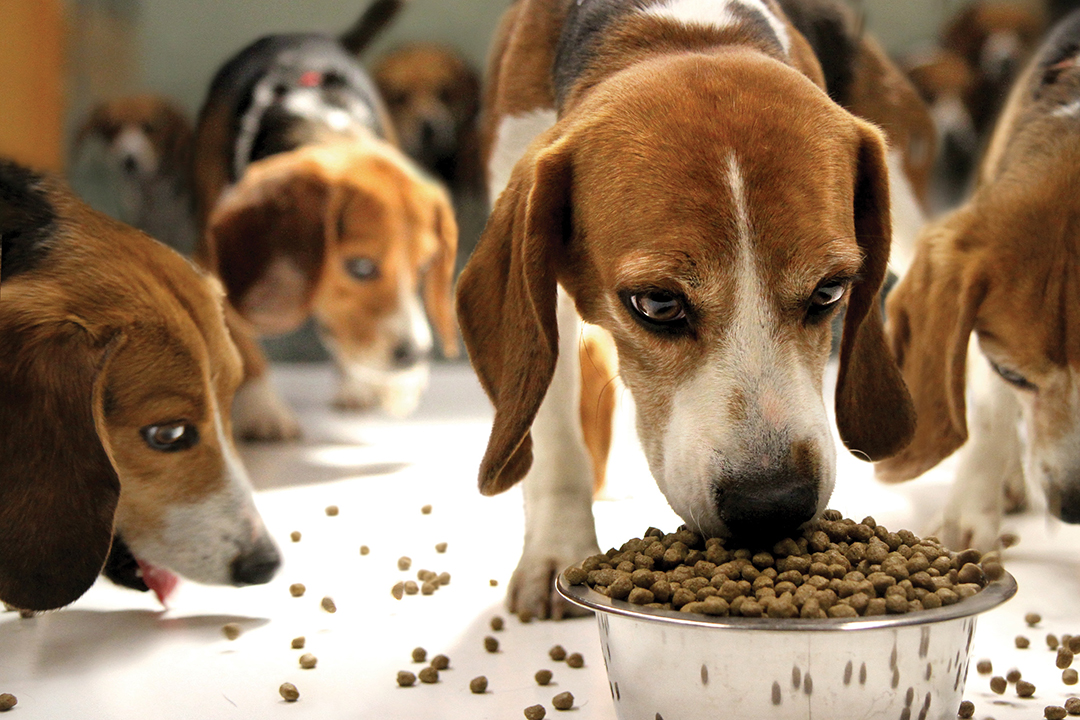
The "protein illusion": nitrogen doping in pet food
Having trouble deciding on a new pet food for your furry family member? With the hundreds of pet food brands stocked on store shelves, choosing the most nutritious one can be a daunting task for any pet owner.
By Andrea GeigerBecause controversy often surrounds pet food companies, consumers are legitimately concerned that their pets may be consuming questionable ingredients that could be harmful to them.
Following regulations is voluntary in the pet food industry and often only big name brands publish the list of ingredients with a nutritional analysis on each bag of food. However, some of that information can be misleading.
Those inaccuracies are the focus for Dr. Lynn Weber and a team of researchers from the Western College of Veterinary Medicine's Department of Veterinary Biomedical Sciences and the University of Saskatchewan's Toxicology Centre. They're attempting to separate fact from fiction when it comes to pet foods.
Weber and her research team are conducting a series of digestibility and nitrogen retention studies using a group of eight beagles and eight cats.
The animals will be given feed from four popular pet food brands as well as a control feed. The pet foods chosen for the study will range in price from cheap to expensive.
In particular, the scientists are focusing on nitrogen retention and the amount of usable protein in the pet foods – a detail that’s not as straightforward as one might think.
“Nitrogen retention is the reflection of how much nitrogen from the diet an animal absorbs and uses to build tissue and muscle,” states Weber. “However, the crude protein content advertised on pet food bags is not always an accurate reflection of the nitrogen that is readily retained or ‘useful nitrogen.' By running these trials, we will be able to see what percentage of the advertised crude protein is actual useful protein."
If it’s not actual usable protein that is listed under the crude protein section of pet food, then what is it? Protein is primarily determined by nitrogen content, but the crude protein in pet food may include nitrogen that isn’t actually protein – often that nitrogen is not from animal tissues and is referred to as “non-protein nitrogen."
While non-protein nitrogen can be incorporated from either natural or unnatural sources, the common source of non-protein nitrogen in pet foods is from plant ingredients.
Pet food manufacturers or ingredient suppliers to pet food companies may or may not know that they’re involved in this practice, known as “doping.” If a pet food company or ingredient manufacturer is purposely doping their product, it’s usually because non-protein nitrogen is cheaper to incorporate than actual animal tissue, thus allowing for a larger overall profit.
While adding plant nitrogen falsely increases the reported percentage of protein in pet food, it doesn’t interfere with the health of the animal – sadly, that’s not the case with all of the ingredients that may be added.
“Unfortunately some harmful substances like nitrate, nitrite and ammonia added to the diet will also increase apparent nitrogen,” says Weber. “These substances are often added as antimicrobial preservatives and colour agents and are not added with the direct intention of nitrogen doping.”
The 2007 melamine crisis is one example in which a number of pet food manufacturers unknowingly used ingredients from an ingredient supplier that doped their product using potentially harmful substances.
Melamine, a chemical used in the manufacturing of plastics, was confirmed in several samples of wheat gluten taken from pet food. Despite a major recall on pet food, many dogs and cats suffered from kidney toxicity, and several animals died.
While big pet food companies now screen ingredients for melamine, nitrates and nitrites are substances that may still be found in the product. These compounds can cause low oxygen, lethargy and methemoglobinemia – all potentially harmful to pet health. Nitrate is also a known human and animal carcinogen.
Because the ingredient provider may be the one at fault, pet food companies may be unaware that they’re purchasing tainted ingredients.
Furthermore, since the majority of pet food companies receive their ingredients from the same provider, there may be several companies selling pet food that contains non-protein nitrogen sources.
The best advice for consumers is to stick with a brand they know – the one that works for their pets. It’s also beneficial to critically compare the crude protein percentage with the listed ingredients and make an informed decision based on the label.
Regulating animal nutrition is one of the best ways to ensure that consumers can make informed decisions that ensure they buy good quality food that keeps their pets happy and healthy.
Andrea Geiger of Medicine Hat, Alta., is completing her Master of Science degree in toxicology. Geiger was part of the WCVM’s Undergraduate Summer Research and Leadership program in 2017. Andrea’s story is part of a series of stories written by WCVM summer research students.
Click here to read more pet health stories in the Winter 2018 issue of Vet Topics.
